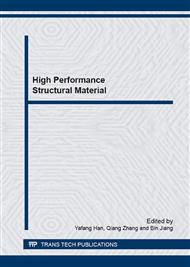[1]
Xiao, Li, Zan, Liao, Xu, and Duan, Growth of Metal–Metal Oxide Nanostructures on Freestanding Graphene Paper for Flexible Biosensors. Adv. Funct. Mater. 22(12) 2012: pp.2487-2494.
DOI: 10.1002/adfm.201200191
Google Scholar
[2]
Chen, Ren, Gao, Liu, Pei, and Cheng, Three-dimensional flexible and conductive interconnected graphene networks grown by chemical vapour deposition. Nat Mater. 10(6) 2011: pp.424-428.
DOI: 10.1038/nmat3001
Google Scholar
[3]
Yan, Li, Chandra, Tulevski, Wu, Freitag, Zhu, Avouris, and Xia, Tunable infrared plasmonic devices using graphene/insulator stacks. Nat Nano. 7(5) 2012: pp.330-334.
DOI: 10.1038/nnano.2012.59
Google Scholar
[4]
Luo, Jiang, Zhang, Jiang, and Liu, A novel non-enzymatic glucose sensor based on Cu nanoparticle modified graphene sheets electrode. Anal. Chim. Acta. 709(0) 2012: pp.47-53.
DOI: 10.1016/j.aca.2011.10.025
Google Scholar
[5]
Kirkland, Schiller, Medhekar, and Birbilis, Exploring graphene as a corrosion protection barrier. Corros. Sci. 56(0) 2012: pp.1-4.
DOI: 10.1016/j.corsci.2011.12.003
Google Scholar
[6]
Novoselov, Falko, Colombo, Gellert, Schwab, and Kim, A roadmap for graphene. Nature. 490(7419) 2012: pp.192-200.
DOI: 10.1038/nature11458
Google Scholar
[7]
Wassei and Kaner, Oh, the Places You'll Go with Graphene. Accounts Chem Res. 46(10) 2013: pp.2244-53.
DOI: 10.1021/ar300184v
Google Scholar
[8]
Paton, Varrla, Backes, Smith, Khan, O'Neill, Boland, Lotya, Istrate, King, Higgins, Barwich, May, Puczkarski, Ahmed, Moebius, Pettersson, Long, Coelho, O'Brien, McGuire, Sanchez, Duesberg, McEvoy, Pennycook, Downing, Crossley, Nicolosi, and Coleman, Scalable production of large quantities of defect-free few-layer graphene by shear exfoliation in liquids. Nat Mater. 13(6) 2014: pp.624-630.
DOI: 10.1038/nmat3944
Google Scholar
[9]
Prasai, Tuberquia, Harl, Jennings, and Bolotin, Graphene: Corrosion-Inhibiting Coating. ACS Nano. 6(2) 2012: pp.1102-1108.
DOI: 10.1021/nn203507y
Google Scholar
[10]
Singh, Nayak, Nanda, Jena, Bhattacharjee, and Besra, The production of a corrosion resistant graphene reinforced composite coating on copper by electrophoretic deposition. Carbon. 61(0) 2013: pp.47-56.
DOI: 10.1016/j.carbon.2013.04.063
Google Scholar
[11]
Singh Raman, Chakraborty Banerjee, Lobo, Gullapalli, Sumandasa, Kumar, Choudhary, Tkacz, Ajayan, and Majumder, Protecting copper from electrochemical degradation by graphene coating. Carbon. 50(11) 2012: pp.4040-4045.
DOI: 10.1016/j.carbon.2012.04.048
Google Scholar
[12]
Chang, Huang, Peng, Yeh, Lu, Hung, Weng, Yang, and Yeh, Novel anticorrosion coatings prepared from polyaniline/graphene composites. Carbon. 50(14) 2012: pp.5044-5051.
DOI: 10.1016/j.carbon.2012.06.043
Google Scholar
[13]
Zhou, Li, Shenoy, Li, and Liu, Enhanced Room-Temperature Corrosion of Copper in the Presence of Graphene. ACS Nano. 7(8) 2013: pp.6939-6947.
DOI: 10.1021/nn402150t
Google Scholar
[14]
Kumar, Venkatesha, and Shabadi, Preparation and corrosion behavior of Ni and Ni–graphene composite coatings. Mater. Res. Bull. 48(4) 2013: pp.1477-1483.
DOI: 10.1016/j.materresbull.2012.12.064
Google Scholar
[15]
Liu, Wang, Luo, Tang, and Chen, Direct Electrodeposition of Graphene Enabling the One-Step Synthesis of Graphene–Metal Nanocomposite Films. Small. 7(9) 2011: pp.1203-1206.
DOI: 10.1002/smll.201002340
Google Scholar
[16]
Li, Muller, Gilje, Kaner, and Wallace, Processable aqueous dispersions of graphene nanosheets. Nat Nano. 3(2) 2008: pp.101-105.
DOI: 10.1038/nnano.2007.451
Google Scholar
[17]
Lotya, Hernandez, King, Smith, Nicolosi, Karlsson, Blighe, De, Wang, McGovern, Duesberg, and Coleman, Liquid Phase Production of Graphene by Exfoliation of Graphite in Surfactant/Water Solutions. J. Am. Chem. Soc. 131(10) 2009: pp.3611-3620.
DOI: 10.1021/ja807449u
Google Scholar
[18]
Yu, Zeng, Zhao, Li, Wu, and Xue, Patterned tailored hydrophobic films designed by synergy effect of electrochemical deposition and chemical deposition. Chem. Commun. 49(24) 2013: pp.2424-2426.
DOI: 10.1039/c3cc00207a
Google Scholar


